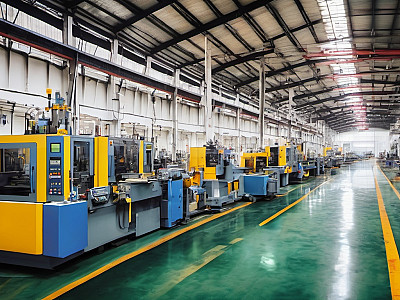Like any dynamic industry, Indonesia’s manufacturing sector is not without challenges. However, it’s precisely these challenges that serve as catalysts for innovation, growth, and the pursuit of excellence.
In this article, we will delve deeper into the multifaceted hurdles faced by Indonesia’s manufacturing industry. We will also explore the transformative strategies that can turn these challenges into stepping stones toward a more resilient and globally competitive future.
Indonesia’s Manufacturing Industry: The Crucible of Transformation
Before diving into the primary challenges Indonesia’s manufacturing sector currently faces, it’s crucial to understand the role this industry plays in the country’s overall Gross Domestic Product (GDP).
As per Statista’s data, in 2022, the manufacturing industry contributed a substantial 18.34% of Indonesia’s GDP share, securing the top position among other sectors.
The whole and retail trade sector followed at 12.58%, agriculture, forestry, and fishing at 12.4%, mining and quarrying at 12.22%, and construction at 9.77%.
When we look at a more recent figure, the manufacturing sector also maintains its prominence in Indonesia’s national GDP structure this year. It contributed 5.02% (or approximately IDR 254.6 trillion) to the overall national GDP in Q1 2023.
Additionally, while the Manufacturing Purchasing Manager’s Index (PMI) for Indonesia registered at 51.5 in October–a drop from September’s index at 52.3–the industry’s achievement to get above the 50-point mark for the last two years indicates a consistent expansionary phase.
This noteworthy achievement underscores the resilience of Indonesia’s manufacturing industry, driven strongly by domestic demand, even against the backdrop of uncertain global conditions.
How Does Indonesia’s Manufacturing Industry Compare to Other Countries?
Ranked fifth globally in cost-effectiveness for manufacturing, Indonesia stands out due to factors like competitive labor costs and operational expenses.
This ranking indicates that manufacturing goods in Indonesia is generally more cost-efficient than in many other countries.
However, when choosing manufacturing locations, investors also weigh multiple factors, such as skilled labor availability, infrastructure, political stability, and market access.
For instance, China boasts superior infrastructure compared to most Southeast Asian countries, while Canada and the United States offer abundant resources, labor pools, incentives, and extensive markets.
Singapore and Germany also attract more interest due to their transparency, infrastructure investments, and geopolitical stability.
What are the Main Challenges of the Manufacturing Industry in Indonesia?
Now that we know Indonesia’s position in the global manufacturing landscape, let’s dig into the multifaceted challenges this particular sector currently faces.
So, what are the main challenges of the manufacturing industry in Indonesia, and what has the government done to alleviate these hurdles?
1. Infrastructure Overhaul
Infrastructure issues are the main challenge that hinders Indonesia’s manufacturing capability. To make Indonesia a more attractive destination for global investors, an infrastructure overhaul is necessary.
Therefore, the current government has committed to enhancing infrastructure development, focusing on projects such as the revitalization of airports, railways, toll roads, renewable power plants, and the construction and upgrading of ports.
2. Skilled Workforce Renaissance
Indonesia offers relatively low labor costs, ranging from USD 95 to 350 per month, with the manufacturing sector employing over 19 million people in 2022.
Despite being a major workforce contributor, particularly in food, apparel, and textile manufacturing, the majority lacks the digital and technical skills crucial for Industry 4.0.
Addressing this gap, the government initiated the Indonesia Digital Industry Center 4.0 (PIDI 4.0) as part of a national priority program.
If executed effectively by 2025, Industry 4.0 is projected to contribute around USD 121 billion to Indonesia’s GDP. It will also prepare the ground for a rapid adoption of emerging technologies, fostering a culture of continuous innovation.
3. Streamlining the Regulatory
The regulatory landscape can be a maze for businesses, slowing down processes and increasing costs.
Streamlining regulations and embracing a more transparent and business-friendly approach can significantly reduce this bureaucratic burden and encourage both local and foreign investments.
The government has initiated the development of Special Economic Zones (SEZs) in Indonesia to spur investment and create opportunities.
This strategic project, prioritized since 2009 and significantly expanded in 2020-2021, offers fiscal and non-fiscal incentives to attract direct investment and enhance industrial competitiveness.
As of December 2023, 20 SEZs in Indonesia have achieved investments totaling IDR 167.2 trillion, marking a substantial increase of IDR 62.9 trillion from the previous year.
Gresik, East Java, and Kendal, Central Java currently host the largest SEZs in Indonesia.
Forging the Manufacturing’s Path
Despite infrastructure hurdles, the sector’s resilient growth, coupled with the government’s commitment to overhauling infrastructure, fostering a skilled workforce, and streamlining regulations, positions Indonesia for a more competitive future.
Need insights into the state of Indonesia’s manufacturing industry? Connect with Askpert.id’s expert network now and ensure you have comprehensive information about Indonesia’s developing manufacturing sector.

Leave a Reply